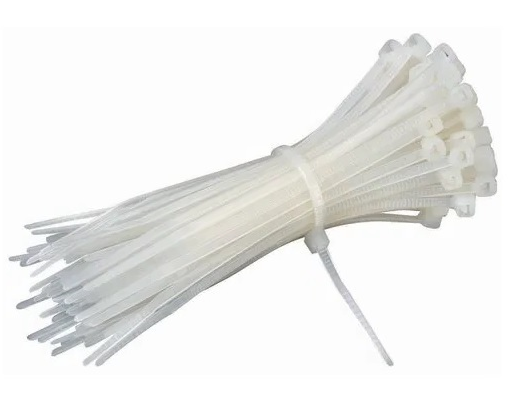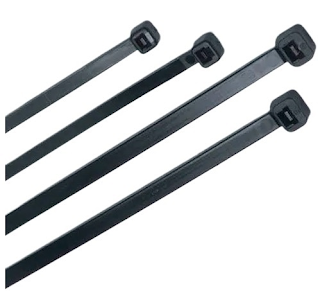Cable tie | Cable tie size
Cable tie, also known as zip ties or tie wraps, are commonly used in a variety of applications to bundle or secure objects together. They are versatile, easy to use, and available in various sizes, colors, and materials. In this article, we will discuss cable tie and cable tie size in detail, including their history, applications, types, and best practices for using it
History of Cable Ties
The invention of cable ties can be traced back to the early 1950s when electrical engineer Maurus C. Logan patented a new way to fasten wiring harnesses in airplanes. The original design of cable ties was made of metal, but it was later replaced with plastic due to its lower cost and higher durability. Since then, cable ties have become a ubiquitous fastening solution across various industries.
Applications of Cable tie
Cable tie are commonly used in the following applications:
- Electrical: Cable ties are used to secure and organize electrical wires and cables.
- Automotive: Cable ties are used to secure various components in automobiles, such as hoses, cables, and wires.
- Manufacturing: Cable ties are used to bundle and organize parts in the manufacturing process.
- Construction: Cable ties are used to secure pipes, hoses, and cables in construction sites.
- Gardening: Cable ties are used to train and support plants in gardening and agriculture.
Types of Cable tie
Cable ties are available in various types, each with its unique characteristics and applications. The following are some of the most common types of cable ties:
Standard cable tie:
These are the most common type of cable ties and are made of nylon. They come in various sizes and colors and are ideal for general-purpose applications.
Releasable cable tie:
These cable ties can be easily released and reused, making them ideal for applications that require frequent adjustments or modifications.
Heavy-duty cable tie:
These cable ties are thicker and stronger than standard cable ties and are designed to handle more substantial loads. They are ideal for industrial applications.
Stainless steel cable tie:
These cable ties are made of stainless steel, making them resistant to corrosion and ideal for harsh environments.
Best Practices for Using Cable Ties
To ensure the proper use of cable ties, follow these best practices:
- Choose the right cable tie for the application: Select the right cable tie based on the size, strength, and environmental conditions of the application.
- Use the correct tension: Do not overtighten the cable ties as this can damage the objects being fastened. However, ensure that the cable ties are tight enough to prevent movement.
- Cut the excess: After fastening the objects, cut the excess length of the cable tie using a cable tie cutter or a pair of scissors.
- Consider the temperature: Cable ties can become brittle and break when exposed to extreme temperatures. Choose cable ties that are designed for the temperature range of the application.
Cable tie size
Cable ties come in various sizes to suit different applications. The size of a cable tie refers to its length and width. The length of a cable tie typically ranges from a few inches to several feet, while the width can vary from a fraction of an inch to several inches.
When selecting the right size of cable tie, consider the size of the objects being fastened and the weight of the load. If the cable tie is too small, it may not be strong enough to hold the objects together, while a cable tie that is too large may be unnecessarily bulky and wasteful.
Common sizes of cable ties include:
Miniature cable ties:
These are the smallest cable ties and are typically used for small objects such as wires, cables, and hoses. It is usually around 4 inches (100 mm) long and 0.1 inches (2.5 mm) wide.
Standard cable ties:
These are the most common type of cable tie and come in a range of sizes, from 6 inches (150 mm) to 12 inches (300 mm) long and 0.1 inches (2.5 mm) to 0.35 inches (8.9 mm) wide. It is suitable for general-purpose application and can hold objects that weigh up to a few pounds.
Heavy-duty cable ties:
These are thicker and stronger than standard cable ties and are designed to handle heavier loads. It is in various lengths and widths, ranging from (200 mm) 8 inches to 48 inches long and 0.18 inches (4.8 mm) to 0.5 inches (12.7 mm) wide.
Extra-long cable ties:
These are longer than standard cable ties and are used for larger objects such as pipes, cables, and hoses. It range from 20 inches to 60 inches long and 0.3inches (7.6 mm) to 0.5 inches (12.7 mm) wide.
It's essential to choose the right size of cable tie for the application to ensure that it can hold the objects securely without being too tight or too loose.
Summary
Cable ties are a simple but versatile fastening solution that has become an essential part of various industries. Understanding the different types of cable ties, their applications, and best practices for using them can help you choose the right cable tie for your specific needs and ensure that they are used safely and effectively.
FAQ
Q: What are cable ties made of?
A: Cable ties are typically made of nylon, but they can also be made of other materials such as stainless steel, metal, or plastic.
Q: How are cable ties used?
A: Cable ties are used to bundle and secure objects together, such as wires, cables, hoses, and pipes. They are often used in construction, electrical, automotive, and manufacturing industries.
Q: Are cable ties reusable?
A: It depends on the type of cable tie. Standard cable ties are designed to be used once and cannot be reused. However, releasable cable ties can be released and reused multiple times.
Q: How do you remove a cable tie?
A: To remove a cable tie, use a cable tie cutter or a pair of scissors to cut the tie as close to the locking mechanism as possible.
Q: Can cable ties be recycled?
A: Nylon cable ties can be recycled, but it depends on the recycling facilities available in your area. Check with your local recycling facility to see if they accept nylon cable ties.
Q: What is the maximum weight that a cable tie can hold?
A: The maximum weight that a cable tie can hold depends on the type and size of the cable tie. Heavy-duty cable ties are designed to hold heavier loads than standard cable ties. It's important to select the right cable tie for the weight of the objects being fastened.
Q: Can cable ties withstand extreme temperatures?
A: It depends on the type of cable tie. Nylon cable ties can withstand temperatures of up to 185°F, while stainless steel cable ties can withstand higher temperatures. It's essential to choose the right cable tie for the temperature range of the application.
Q: How do you choose the right size of cable tie?
A: To choose the right size of cable tie, consider the size of the objects being fastened and the weight of the load. If the cable tie is too small, it may not be strong enough to hold the objects together, while a cable tie that is too large may be unnecessarily bulky and wasteful.
Q: What is the best way to store cable ties?
A: Cable ties should be stored in a cool, dry place away from direct sunlight. Keep them in their original packaging or a storage container to protect them from dust and moisture.










Post a Comment